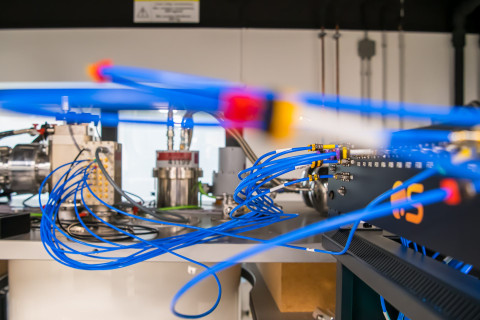ICMM-CSIC is searching the 'kitmon', a hybrid qubit that will allow progress towards more robust quantum computing

The Materials Science Institute of Madrid (ICMM-CSIC) coordinates one of the work packages that is developing a new type of hybrid qubit: the 'kitmon'. The project, financed through Pathfinder grants from the European Commission, has a budget of 4.7 million euros and an estimated duration of four years to create a quantum bit (qubit) tolerant to the coherence errors that currently limit quantum computing.
Qubits are the minimum unit of information in quantum computing and they promise to revolutionize the world of computing as we know it. However, its development is limited: until now, most conventional approaches to quantum computing end up encountering short coherence times of qubits (so-called quantum decoherence), which leads to errors that are difficult to correct.
Getting better qubits would allow for fault-tolerant computing, and that is precisely the goal of the international teams participating in the project. "We are going to create a qubit from a different concept," advances Ramón Aguado, an ICMM-CSIC researcher who participates in the project.
This work proposes an innovative approach by proposing a hybrid qubit between superconducting and semiconductor platforms: the knowledge and techniques already developed for superconducting qubits will be taken advantage of, but the most dominant sources of errors will be eliminated. "Their states will be immune to most of the decoherence mechanisms that currently limit the quantum computer," defends Aguado who, although he recognizes that the new qubit will not be completely protected, it will be a first step. In addition, it highlights that it will not have difficulty being scalable, as it is based on semiconductor materials.
“We start from an experimental system in which it has already been shown that two quantum dots coupled through a superconductor perfectly simulate a Kitaev chain, a minimal model to achieve topological states. This chain will be combined in a Josephson junction with a 'transmon' type superconducting circuit, with which you can implement a type of qubit designed to have reduced sensitivity to charge noise. The union of both will give rise to Kitmon,” Aguado clarifies.
The working method plans to encode quantum information in a topologically protected system thanks to the union of both platforms. "The integration of the Kitaev chain into a transmon architecture will allow us to perform one- and two-qubit operations using well-established control techniques in the field of superconducting qubits," adds María José Calderón, ICMM-CSIC researcher who is also part of the project.
The international consortium involves the University of Delft (TU Delf), the IOM Materials Foundry of the Italian National Research Center (CNR), the Austrian Institute of Science and Technology (ISTA), the Energiatudomanyi Kutatokozpont (EK), and the University from Augsburg, as well as the company Orange Quantum Systems. The latter describes the work process like this: "The starting point will be a state-of-the-art two-dimensional hybrid superconducting-semiconductor platform developed by the IOM. Subsequently, TU Delft, ISTA, EK, ICMM-CSIC and the University of Augsburg will carry out the chain Kitaev and will incorporate it into a Kitmon architecture. Finally, Orange QS will ensure that Kitmon qubits can be controlled and tested with a well-integrated hardware-software system".
Instituto de Ciencia de Materiales de Madrid (ICMM)
Sor Juana Ines de la Cruz, 3
Cantoblanco, 28049
Madrid, España
Telephone: (+34) 91 334 90 00
Email: @email
Communication Office: @email

Acknowledge the Severo Ochoa Centres of Excellence program through Grant CEX2024-001445-S/ financiado por MICIU/AEI / 10.13039/501100011033

Contacto | Accesibilidad | Aviso legal | Política de Cookies | Protección de datos